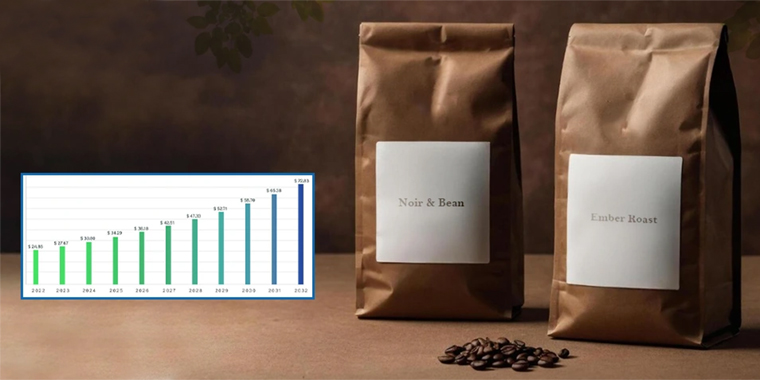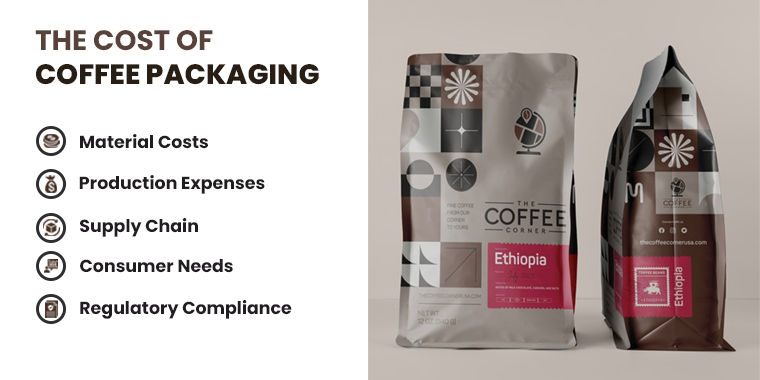September 16, 2025

Green coffee packaging is more than a trend. Consumers prefer eco-friendly products, and businesses must respond accordingly. That's why it's a necessity, nowadays.
But, balancing cost and sustainability in coffee packaging is challenging. Many greener alternatives come with higher initial costs, This makes it difficult for brands to stay profitable.
So, how to keep the right balance? The answer lies in smart material choices and understanding consumer expectations.
This blog will explore different strategies to balance cost and sustainability in coffee packaging. It will help brands make wise decisions for the betterment of their business and the environment. So, let’s get started!
Switching to green coffee packaging is not just reducing costs. It benefits brands, consumers, and the planet. Let’s discuss how:

The cost depends on several factors. Some of them are described below:
Material Costs: Normal materials like plastic are cheap, but green materials like recycled paper are expensive.
Production Expenses: Eco-friendly materials require specialized manufacturing. It increases costs.
Supply Chain: Sustainable packaging is heavier. This affects transportation costs.
Consumer Needs: People are ready to pay more for green packaging options. However, brands must ensure affordable prices.
Regulatory Compliance: Many regions have strict regulations that must be followed. It can increase costs.
Selecting the right materials is significant. Here are some greener options and how they impact cost and sustainability.
These materials break down naturally over time, reducing waste. These include:
Compostable Bags: These coffee bags are made from cornstarch.
Cellulose Films: These originated from wood pulp.
Polylactic Acid: It is made from renewable sources.
Environmentally friendly.
Reduces waste accumulation.
Attracts eco-conscious consumers.
Higher production costs.
Requires specific composting conditions.
May degrade faster than traditional materials.
These materials are reused to create new products. This minimizes waste. Common options include:
Mono Plastic: They are easier to recycle than other plastics.
Aluminum-Free Laminate: It allows simple recycling processes.
Recyclable Paper Bags: These white paper bags reduce reliance on virgin paper.
Lower long-term costs.
Reduces demand for new raw materials.
Supported by most waste management systems.
Requires consumer participation for proper recycling.
Some packaging materials degrade in quality after recycling.
Using these materials in coffee packaging reduces the need for new resources. This includes:
Post-Consumer Recycled Plastic: It reduces plastic waste.
Recycled Kraft Paper: It offers durability and provides a natural look.
Affordable compared to virgin materials.
Helps achieve circular economy goals.
Meets environmentally friendly certifications.
They have limited durability.
Color and texture variations may occur.
Need higher energy during processing.

A carefully crafted packaging design can lower costs and maintain sustainability. Here are some strategies:
Reducing the amount of material cuts down on costs and waste. Lightweight packaging reduces shipping expenses.
Removing unnecessary layers and decorations simplifies production. Using natural dyes instead of heavy printing also reduces costs and environmental impact.
Pouches made from green materials require fewer resources and low production costs. These are also easier to transport.
Some brands encourage consumers to refill their coffee bags. This reduces waste and ensures a greener future.
Advancements in packaging help brands add value while ensuring environment friendliness. Such as QR codes that provide freshness tracking.
Consumers want greener options but they also want affordability. Here’s how brands can do it without losing profits:
Educate Consumers - Inform customers about why sustainable packaging matters. This increases brand loyalty.
Provide Offers - Provide discounts for customers who return packaging for recycling purposes.
Partner with Eco-conscious Suppliers - Work with suppliers who offer bulk discounts on green materials.
Transition Gradually - If the full shift is too expensive, start by making small changes. Like switching to recycled kraft labels.
Clear Labeling - Indicate which packaging elements are eco-friendly to build consumer trust.
Many brands are adopting green packaging alternatives. For example, In 2023, Nestle was ranked first by the Coffee Brew Index.

Coffee packaging must protect freshness while meeting sustainability goals. Here are key considerations in this regard:
Protection: Packaging should protect the coffee from oxygen and moisture. This helps to retain its flavor.
Shelf Life: Compostable packaging has a shorter shelf life, so airtight seals must be used with it.
Resealable Features: Zip locks help keep coffee fresh. They also reduce wastage.
Regulatory Compliance: Packaging must meet food safety and sustainability regulations in different regions.
Customization: Custom printed coffee packaging options help brands differentiate themselves while maintaining environment friendliness.
Also Read: Discover The key Roles Of Customized Boxes In the Food Industry
Balancing cost and sustainability in coffee packaging is not an easy task. It can be done by selecting the right materials and educating consumers. This way brands can reduce costs and stay environmentally friendly.
The key is to find a packaging solution that fulfills your business goals and consumer needs. Sustainable packaging is an investment for a greener future.
At Custom Designs Boxes, we specialize in greener packaging that fits your budget. Contact us today via email at sales@customdesignsboxes.com to explore numerous options for your coffee brand!
Find the perfect packaging solutions tailored to your industry niche.
Don't just imagine – experience excellence up close, as you can check our superior craftsmanship before making your decision by ordering your sample kit.
